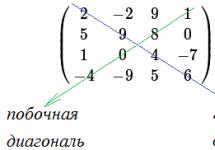For interior decoration houses and apartments use a lot of facing materials. However, if you want your house or apartment to look stylish and truly unusual, pay attention to such finishing material as artificial stone. Almost perfectly imitating natural stone for interior cladding of apartments, artificial significantly wins in cost. The variety of the color palette of this material allows you to embody and combine the most daring and original ideas for decorating the interior of an apartment with a stone.
Apartment interior with artificial stone
Construction stores offer artificial stone made on a gypsum basis, porcelain stoneware, acrylic products, etc. Finishing material of this type is more convenient to install, because it does not have the weight of natural stone. Such a parameter as weight also affects the transportation of the product, which ultimately significantly reduces the cost of material for interior stone finishing of an apartment.
Fake diamond, for the creation of which a gypsum base was used, has long won authority among the finishing materials used for interior decoration of apartments. The demand for gypsum products is due to its undoubted advantages: a loyal price, excellent thermal insulation qualities, environmental properties. In addition, the light weight of such gypsum material for finishing an apartment greatly facilitates its installation.
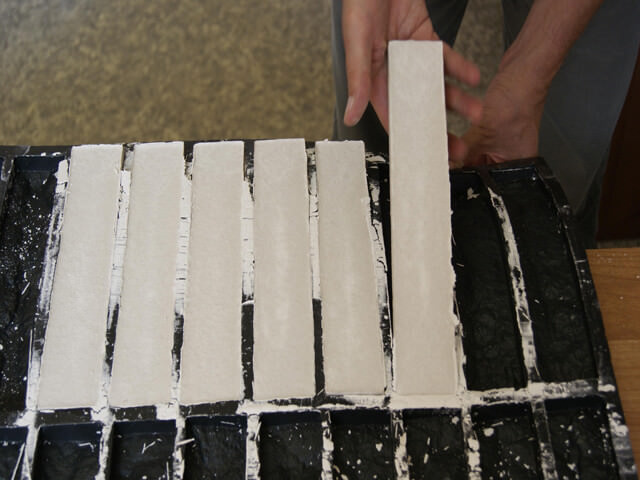
Gypsum artificial stone only from the mold
Gypsum artificial stone is used only for interior decoration of the walls of the apartment, this is due to the fact that it does not tolerate low temperatures. The porous surface of gypsum products limits their use in kitchens and bathrooms. Although it is possible to increase the moisture resistance of such an artificial stone with the help of special protective varnishes and coatings.
Artificial stone on a concrete basis
Finishing material, for the manufacture of which sand, plasticizers, coloring elements, components that increase strength were used. In addition, the product may include expanded clay (granules or dust), pumice. Artificial stone based on concrete can be used for finishing any walls, because it is particularly versatile. It can even be used for outdoor finishing work.
There is also the so-called reinforced artificial stone made of concrete. It is used to create slabs, cobblestones, boulders of a natural look.
Acrylic facing stone
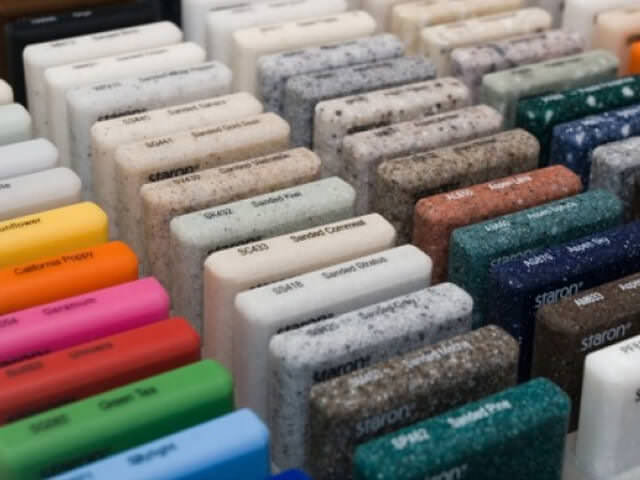
Rich colors of acrylic stone
Artificial stone from acrylic components at the moment, this is one of the most popular materials for interior decoration of apartment walls. Its distinguishing features are: moisture resistance, resistance to low temperatures, such a stone can be cleaned with ordinary rags, it is safe for the environment and human health. In case of fire, artificial acrylic stone does not burn, but only melts. It is noteworthy that the acrylic stone has not only a solid service life, but also the ability to restore it if necessary.
Facing stone from porcelain stoneware
The composition of this material includes: kaolin clay, feldspar, sand, oxides of chromium, iron, manganese. These elements are subjected to crushing and grinding, after which they are given a certain shape with the help of a press at a temperature of at least 1200 degrees. The resulting product has such qualities as strength, moisture resistance, wear resistance, cold resistance. Artificial stone from porcelain stoneware is able to withstand impact chemical elements, does not pass electric current, is antistatic and has an attractive appearance. These advantages initiated the use of stone from such a material not only for interior, but also for exterior decoration.
Stone based agglomerate
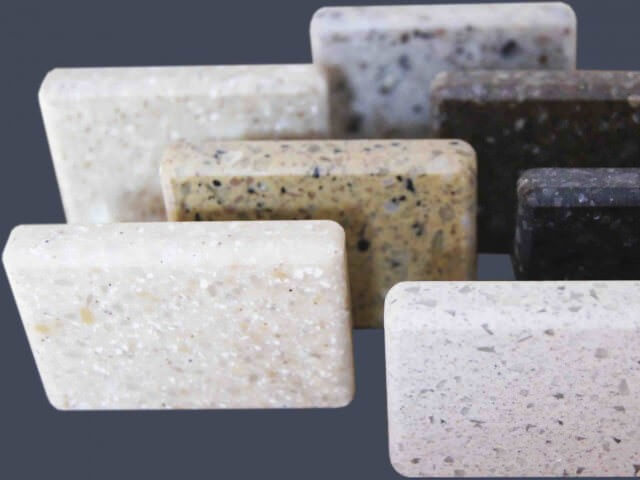
Artificial quartz is indistinguishable from natural
The composition of this type of facing stone includes a crumb of granite, marble or quartz, there are coloring pigments. As a binding base, cement or possessing high quality polyester resins. As a rule, quartz is used as a filler, which makes up the majority of the mixture. This is due to the fact that it has increased strength.
Resin-based finishing material is used to decorate interior items such as the surface of tables, window sills, steps, counters, etc. Cement bonded stone is mainly used to decorate the walls of a house on the street.
Applications
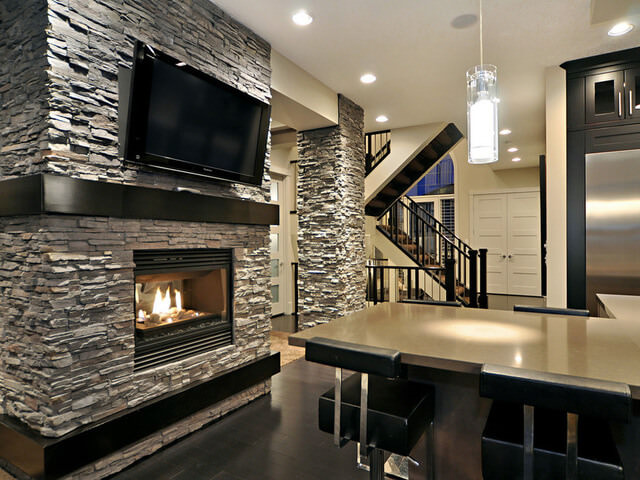
Modern fireplace with faux stone cladding
You can use artificial stone for finishing any walls of premises both in the office and in the apartment.
However, it is worth considering specifications finishing material and purpose of the room. For example, you should not even use processed gypsum stone for facade work, because it reacts negatively to low temperatures.
Products made of porcelain stoneware or agglomerate can be safely used for decoration working area kitchens. The thin layer and light weight of the cladding makes it possible to finish with stone not only the walls of the room, but also pieces of furniture. The stone facing of the table in the kitchen will not only give it an original look, but also increase its wear resistance and durability. In the kitchen, where the interior is designed in a modern, simple style, you can find stone trim in the form of marble tiles.
decorative brick
Decorative bricks are great for decorating the walls of a house or apartment, the design of which is designed in the style of medieval castles.
It is appropriate facing brick will look like for decorating a fireplace room in the house. Moreover, a wide range of colors can bring to life even the most bold ideas. Decorative brick is quite often found in the interior decoration of the walls of the premises.
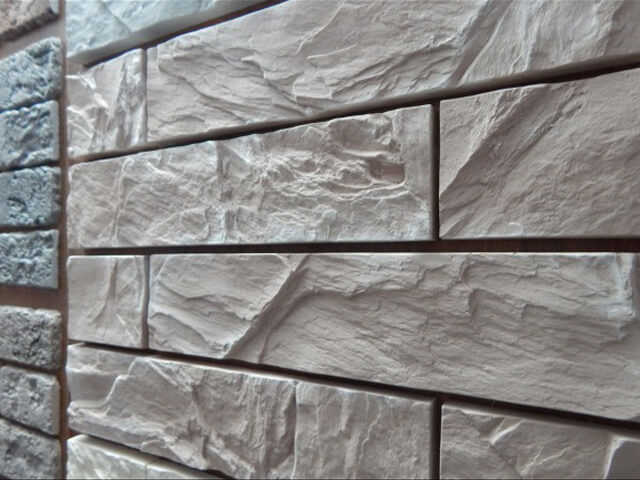
Decorative brick imitating stone
Facing stone in the form brickwork can be used to finish not the entire room, but some of its elements, designed to set off the overall style of the room. The demand for interior decoration with artificial stone is growing from year to year. This is due to the original texture of the material, a rich selection of colors and shades and its natural lines. Decorative brick can be made from all of the above materials, but naturally, its use will be limited by their properties. A wide range of decorative bricks in stores in a wide variety of forms and types allows you to create an apartment style, taking into account the financial capabilities and wishes of the owner.
Decorative brick effect tiles
This finishing material is made in the form of a panel that imitates several brick rows at once. Facing of such a plan is made of ceramics or a mixture of polymers. It is one of the cheapest in this category of goods. Accordingly, the appearance of such panels bears little resemblance to natural, because they have a too regular unnatural look. It does not take much time and effort to install such a product, since one panel imitates two or three bricks at once.
The lining of such a plan is mounted using adhesive mixtures, self-tapping screws or screws. The cost of such material makes the cladding affordable for each consumer. Brick-like decorative slabs are extremely easy to work with, they are easy to cut, and without any problems to form a corner joint or a complex connection.
Brickwork in interior design
Brickwork in the room makes it soft in its own way, gives the atmosphere a kind of warmth and comfort. However, for this it is not at all necessary to lift pallets of bricks into the apartment and bring in cement mortar. This option is fraught with trouble, because a real brick has a solid weight, not to mention problems with neighbors and management company. Facing material in the form of a brick will allow you to give the room a conceived look.
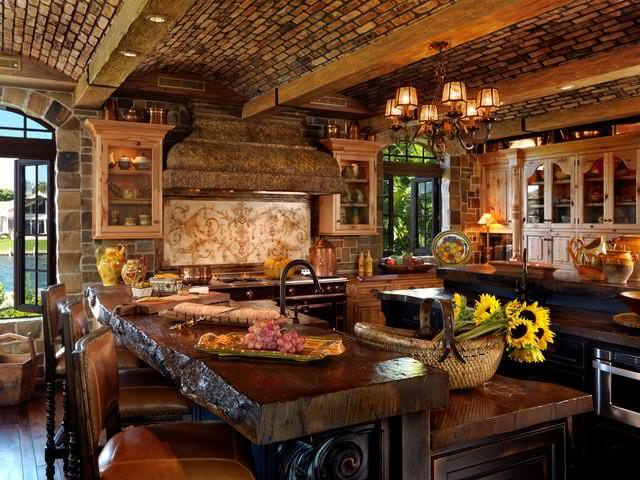
Rustic brick kitchen interior
Decorative materials imitating brick are used in the apartment for decoration doorways, finishing niches, creating columns and partitions, decorating fireplaces. Facing in the form of brickwork for interior decoration is several times thinner than real brick, therefore, when using it, the total area of \u200b\u200bthe room is saved. There are several styles of stone finishing.
Some interior design concepts
Brick finishing of all wall surfaces is proposed if the room is spacious enough and its general interior fits into English style. A small room involves partial stone cladding, in which one wall or functional area is formed. Naturally, if a fireplace is installed in the living room, then such a lining would be more than appropriate. A home theater in a brick frame will also look quite original.
For decoration in the apartment of hallways and bedrooms, the interior of which is decorated in country style, an aged brick would be an ideal option. Some limitations are imposed by the reduced strength of the material, this is due to the fact that it has not been subjected to high-temperature processing. The aged look of this material is given by wood flour added to the mixture or impregnation based on polymers.
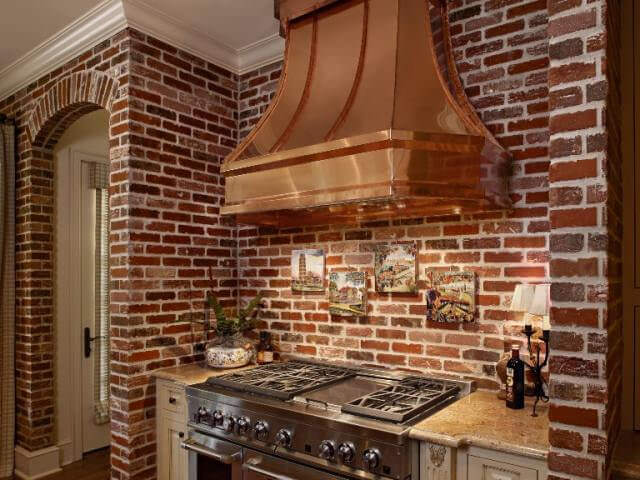
Brickwork in the kitchen in country style
To create an original modern finish, an unmistakable solution would be to use colored brick facing masonry. Manufacturers have achieved perfection in the creation of such materials. Especially relevant is the use of such a finish for decorating the walls of a bathroom or nursery.
There are a number of small restrictions that exist when decorating the walls of rooms with artificial stone with facing stone. In particular, you should not stone the walls in a dark room or a narrow corridor. Having resorted to such material for interior decoration of the apartment, make sure that the rooms have sufficiently bright lighting. Otherwise, the interior may turn out to be gloomy and dull.
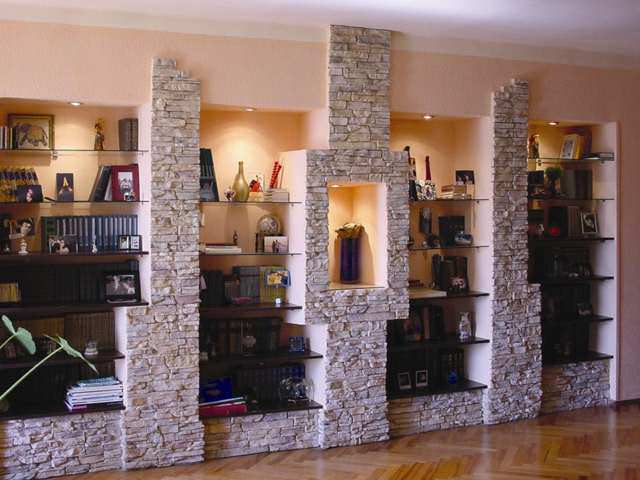
An example of finishing a niche with artificial stone
Results
Materials that bear the definition of artificial stone are mostly made from natural elements. The difference lies in the fact that natural stone was created by nature, and man took part in the production of facing material. Therefore, it does not lose to natural stone in terms of ecology and safety to human health.
On the contrary, artificially created facing stone has a number of advantages over natural:
- Weight of facing stone.
- Acceptable cost.
- Wide choice of forms for finishing works.
- Wear resistance.
- A large assortment.
Tiles decorative stone much easier to lay on a binder solution. In addition, they are delivered immediately in the desired shape and size. To pass the corners of the walls, special corner elements are provided.
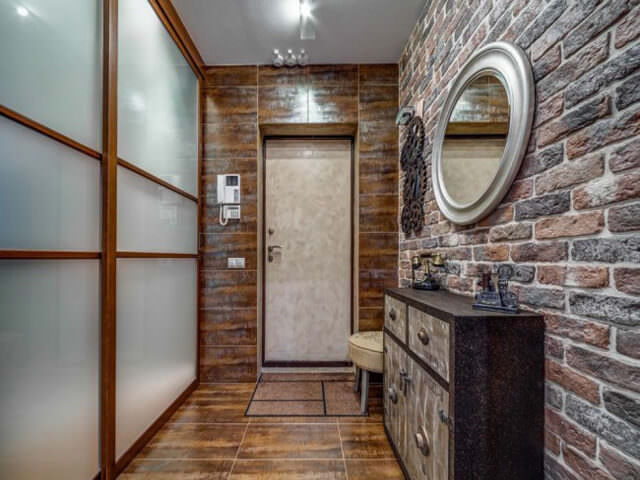
Entrance hall decorated with artificial stone and ceramic tiles
With the help of artificial stone, you can decorate rooms and rooms used for a variety of purposes. Moreover, artificial stone can also be used to decorate a personal plot in a country house or a country house.
String(78) "Artificial stone for internal works"
Decorative stone for interior decoration is extremely popular due to the variety of collection designs. This material organically fits into both modern and classic interior design options, allowing you to create a truly unique flavor in an apartment or house. Also, artificial stone is practically not inferior to natural stone in terms of its performance characteristics, but at the same time it has a favorable cost. The KlinkerStone company offers to buy decorative cladding material for wall decoration on favorable terms. Our catalog contains many collections that imitate the texture of marble, slate, granite, aged brick, etc.
Advantages of artificial stone
Ease of installation. The back of the products has a smooth surface, so the decorative stone is very easy to lay on the walls. Unlike natural material, artificial material is already broken down into compatible elements, which greatly simplifies the finishing of corners and other bends.
A wide range of shapes and textures. It provides an opportunity to endlessly experiment with the interiors of houses, apartments or commercial premises. Imitations of natural rocks, embossed bricks, antique weathered stone, presented in a wide range of colors, will help in creating unique design elements.
Excellent performance. Artificial stone is characterized by low weight, durability, lack of toxic impurities, resistance to temperature extremes, humidity and the appearance of fungus. To improve the characteristics of the material, it can be additionally treated with a water-repellent agent.
Versatility. Decorative stone is suitable for finishing fireplaces, columns, countertops, cornices and other surfaces. The possibilities of its application are almost limitless.
Our range
In the KlinkerStone company catalog, you can choose decorative stone options for wall decoration that are different in shape and color. The range includes products from manufacturers such as Leonardo Stone, Stone Factory, White Hills, and others. To quickly find the optimal type of facing material, you can use the filter, which sorts the items by price, dimensions and other parameters.
To buy a decorative stone, place an order on the website or contact our managers by phone. We offer delivery of goods weighing up to 1500 kg in Moscow and the Moscow region. It is also possible to pick up the order at a convenient time for you.
Stone is not used so often when decorating rooms; it is usually used to focus on one of the walls or its fragment. The laboriousness of the extraction and processing of natural material makes it too expensive for the average consumer, therefore, in finishing work its substitute is used, for example, an artificial stone for interior decoration made of gypsum or acrylic, porcelain stoneware, etc.
Types of artificial stone
This material is conveniently classified depending on the composition. You can select:
- gypsum (more precisely, a tile that imitates the surface natural stone) - quickly hardens, you can make your own hands. Compared to concrete or brick, it weighs less, so the load on the wall will also be low. There are a lot of manufacturers, Monte Alba, Casavaga tiles have proven themselves well, in addition, in almost every major city there are 2-3 companies involved in its production;
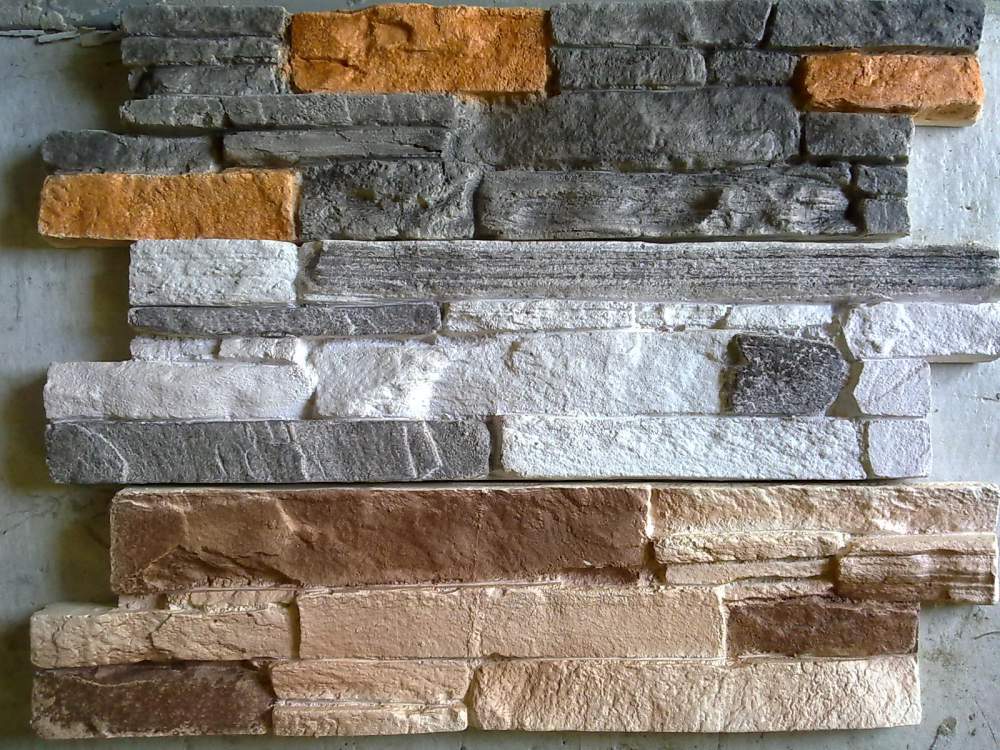
Note! It is undesirable to use it in rooms with high humidity, because gypsum perfectly absorbs moisture.
- acrylic analogue of natural material– practically impervious to moisture (water absorption is 15 times less than that of marble), durable, hard material with a smooth surface;
- porcelain stoneware- resembles ceramics, but much stronger;
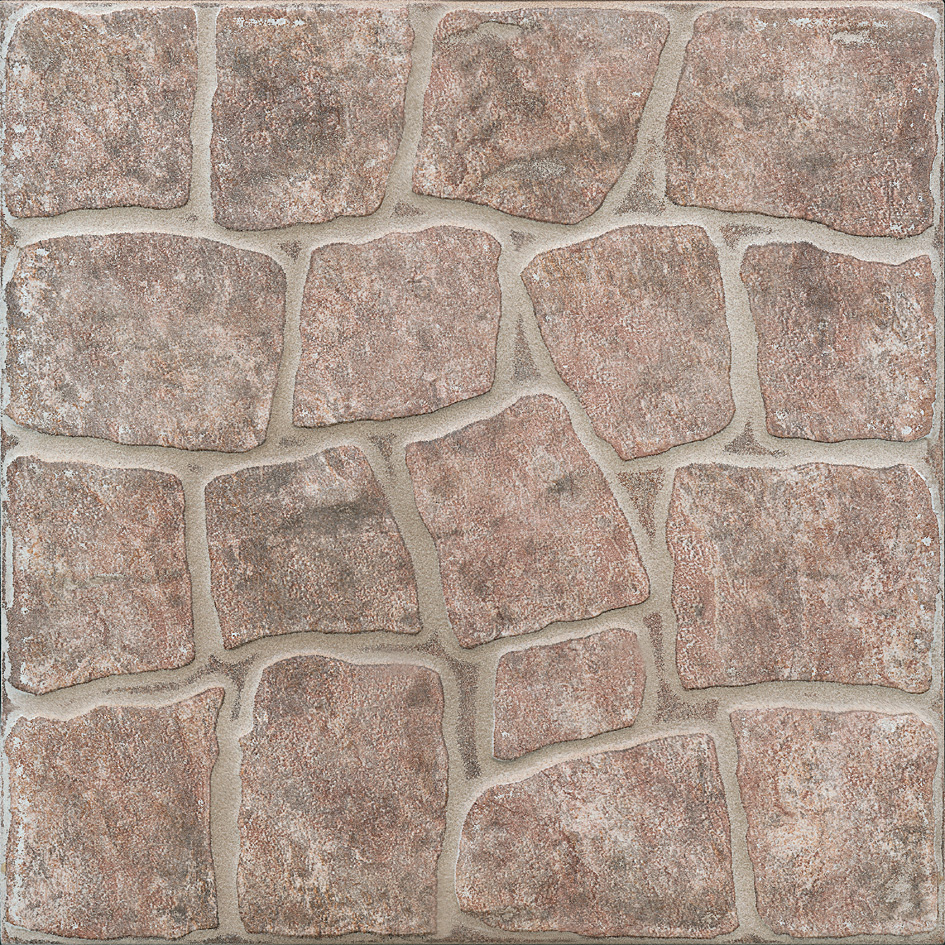
- agglomerates (conglomerates)- a mixture of marble chips, quartz sand, polyester resin, outwardly indistinguishable from natural;
- quartz- one of the most durable, it is very difficult to scratch it with all desire. It is also the most expensive, for example, the price of 1 m 2 of Terra Sabbiosa tiles is approximately $95 (in terms of rubles, about 7200-7300 rubles).
Artificial stone for finishing rooms from the inside is much thinner than natural stone. This is done in order to minimize the additional load on the walls.
Types of finishing material
For the design of rooms can be used:
- artificial brick for interior decoration- looks great in a loft style, where at least one wall imitates old brickwork. Compared to ordinary brick, it is thinner, so that the free space is not greatly reduced;
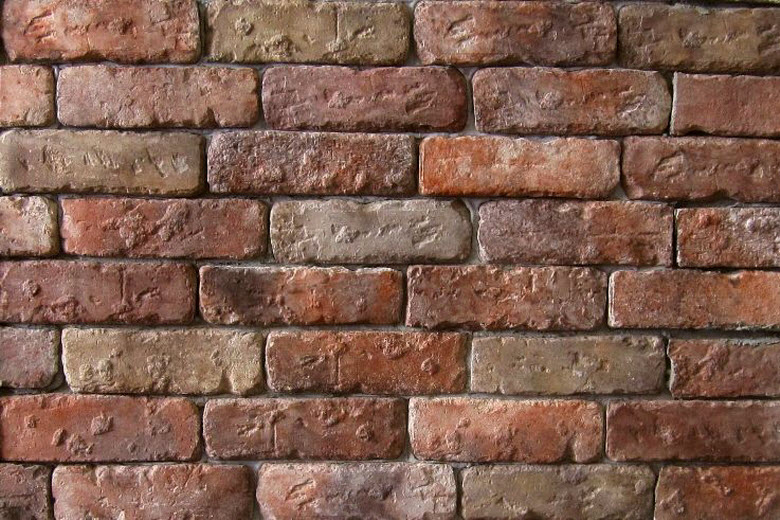
Note! If the finishing will be done in the kitchen, then it is better to choose a clinker finishing material (based on clay). It is more durable and less susceptible to moisture compared to cement or cement-gypsum bricks.
- artificial stone tiles for interior decoration- the front surface imitates the texture of natural material, on the reverse side it is smooth or has a notch for better adhesion to the wall;
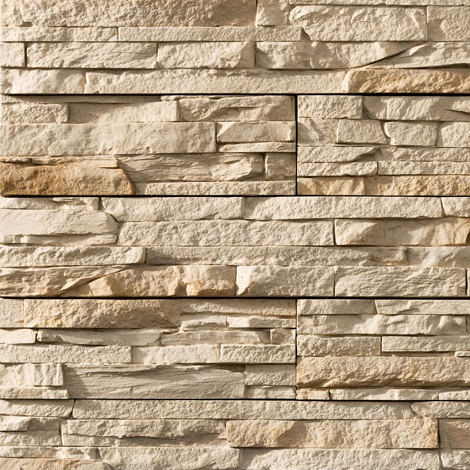
- acrylic slabs- have a small thickness, so that the additional load on the wall will be minimal. There are practically no pores in the structure of the material, so moisture does not penetrate deep into, this is an ideal choice for rooms with high level humidity, for example, for a bathroom;
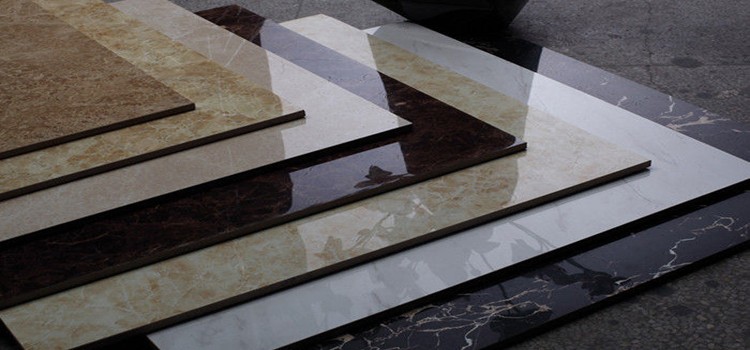
- flexible artificial stone- to call this material a stone can be a stretch. Marble chips or a thin cut of natural sandstone are used, and a layer of resin provides flexibility. The front surface exactly imitates the appearance of natural material, it can be rolled up like ordinary wallpaper. Options are available that imitate brickwork, large stones, or simply with an uneven surface of marble chips;
- artificial stone panels for interior decoration- Differ in large dimensions compared to conventional tiles.
We study the technology of finishing
Regardless of the type used, the main finishing steps are the same - we prepare the base, glue is applied to the tile / brick, and it is pressed against the wall. But there are a number of nuances, so it makes sense to analyze this issue in more detail.
Working with flexible stone
First you need to make a choice, manufacturers offer this material both in the form of rolls and in the form of separate flexible tiles with dimensions from 20x30 cm to 260x130 cm, you can also find plates on an MDF substrate. The choice of the type of flexible stone depends on the shape of the base, if the surface is curved, then the option with MDF will not work.
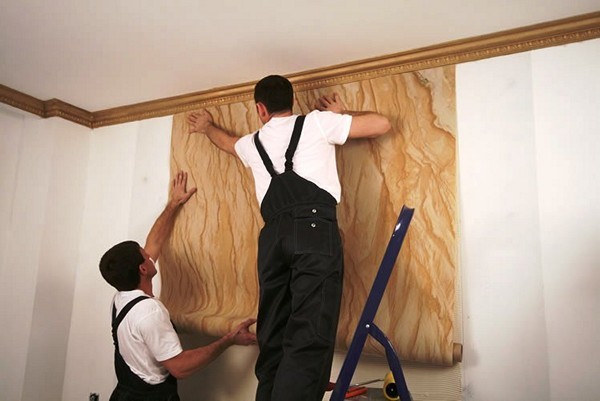
The instructions for finishing the wall will look like this:
- the base, if necessary, puttied, cleaned of dust;
- the adhesive composition is applied to the base and on the reverse side of the tile with a notched trowel;
- the tile is pressed against the wall. If glued a little crooked, then you can attach a small wooden block to its side and tap the hammer to give the desired position;
- from a spray gun or with a brush / roller, the surface of a flexible stone is treated with a hydrophobic solution.
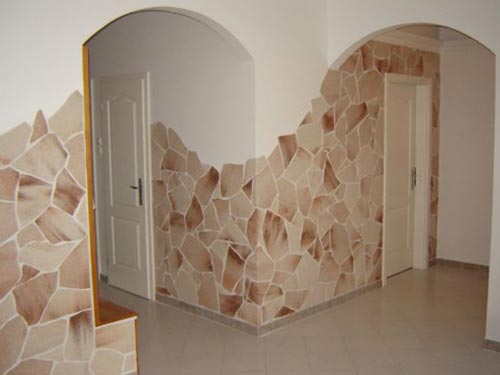
Finishing is desirable to carry out in the direction from the top corner down, near the floor, small trimmings of tiles are likely to be invisible. If, when laying, heat up the edges of the tiles with a building hair dryer and lay them end-to-end, then the coating will turn out without seams, an outside observer will get the impression that the wall is made of stone.
Note! If an interior decoration of a curved surface with an artificial stone is provided, then the tile must be heated with a building hair dryer before bending.
Interior decoration with artificial stone
On the preparatory stage the base is leveled, but in comparison with the cladding with ordinary tiles, strict requirements for evenness are not put forward. The fact is that the front surface of the artificial finishing stone is uneven, therefore, small irregularities in the base will be completely invisible.
It is recommended at the preparatory stage to reinforce the wall with a metal mesh, on top of it it is covered with a layer of plaster, and the tile itself is already glued to it. Reinforcement is necessary when using thick artificial stone, but if, for example, thin decorative brick is used for decoration, then you can do without it.
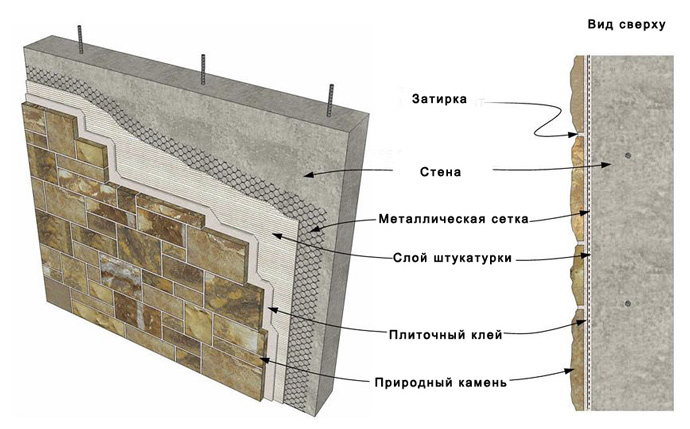
Note! Plasterboard lining is allowed, minimum thickness sheet -12.5 mm. For greater adhesion of the adhesive mixture to the surface of the sheet, it can be scratched before facing.
Cutting can be done manually, using a regular hacksaw, a small grinder, or try a tile cutter. It is possible to lay tiles both end-to-end and with seams (the seams must be tied up as in ordinary brickwork).
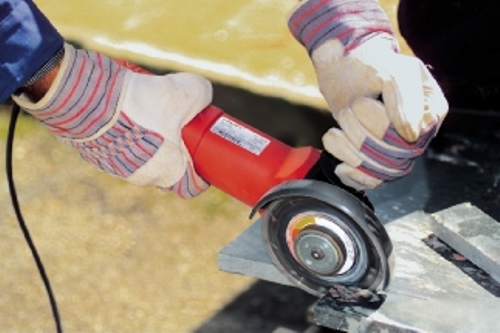
If only a fragment of the wall will be faced, then before facing it is necessary to provide support for the first row. You can simply fix a wooden block on the wall, on which the tiles of the 1st row will rest, after the glue has hardened, it can be removed.
When imitating brickwork, ordinary glazing beads can be inserted between the individual tiles to ensure the required thickness between the individual tiles. After the glue has hardened, the seams are filled with grout, it can be inconvenient to use a rubber spatula (due to the uneven front surface), so we simply remove part of the grout that has fallen on the tile with a wet rag. Alternatively, you can fill the seams with silicone sealant.
![]()
Artificial finishing stone for interior work, it can be treated with a water repellent or varnish (in the case of gypsum stone, this is simply necessary). In addition to additional protection against moisture, this will make the color more saturated and vibrant.
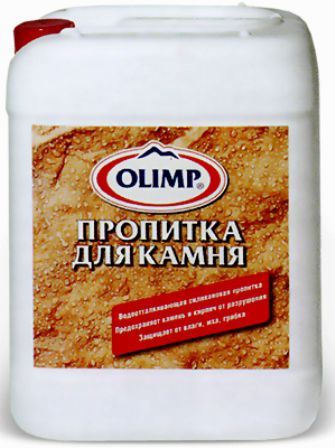
In conclusion
Artificial stone outwardly practically does not differ from natural, while the performance of natural and artificial materials is comparable. Regardless of which type of stone is chosen (imitation brick, tile, large panels), the cladding technology remains the same, so even beginners in the construction business will not have problems.
The video in this article shows a small master class on laying artificial stone tiles.
In the comments, you can clarify the remaining questions about the use of artificial stone for interior decoration of the house.
Finishing works are divided into internal and external. Any modern finishing materials can be used in the process.
Huge popularity in this moment uses artificial stone trim.
For artificial stone is a very practical material. It has a wide variety of sizes and colors and resembles in its own way appearance a natural stone.
To date, there are several varieties of decorative stone:
- Gypsum stone.
- Acrylic.
- Quartz.
Gypsum decorative stone
Gypsum has been used for a long time for the manufacture of finishing materials: stucco, and so on. This material is distinguished by its environmental friendliness.
Also, do not forget that gypsum has excellent sound and heat insulation properties.
Gypsum decorative stone:
- Practical.
- Lasting.
- Ecologicaly clean.
- Has a variety of shades.
- Easy to install.
The price for it is several times cheaper than for. You can make such a stone with your own hands.
For such a process you will need:
- Special forms.
- Lubricant.
- Gypsum.
- Water.
- Container for kneading gypsum dough.
- Coloring agents.
Manufacturing process:
- Initially, gypsum dough is kneaded with the addition of dyes of the desired shade.
- Forms are pre-lubricated, then the dough is poured into the container.
- The time for which the stone should gain the desired strength is several days.
Advice.
To speed up the process self-manufacturing gypsum decorative stone, binders must be added to the solution. Then such a period can be about 1 day.
From gypsum for interior decoration it is quite light and for its installation it will not be necessary to pre-reinforce the surface, strengthening it.
Acrylic decorative stone
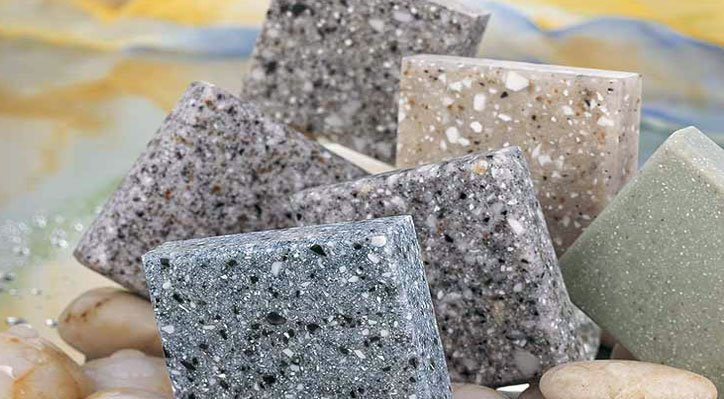
Acrylic artificial decorative stone for interior decoration is currently very popular. It can be used not only in internal, but also in external finishing works.
It will not be possible to make it yourself, like a gypsum stone, since this will require special equipment.
Properties and characteristics of the stone:
- Such a finishing material has excellent technical characteristics.
- It is moisture resistant and its surface is not able to absorb dust and various contaminants.
- Its surface is cleaned with a rag.
Advice. It is not recommended to use abrasive cleaners for cleaning acrylic decorative stone, as they can damage the surface of the stone.
- Acrylic artificial stone is an environmentally friendly material.
- It does not burn, but can only melt.
- In this process, it does not emit substances harmful to the human body.
It is wear-resistant and, if damaged, can be restored quite easily. Acrylic stone is quite easy to install.
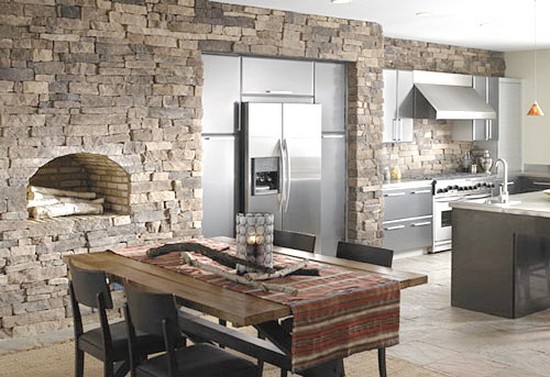
Quartz decorative stone is quite often used in rooms with constant drops. temperature regime and high air humidity. In its manufacture, crumbs of marble, granite and quartzite are used.
Coloring agents are added to them during the production process, which give the material the necessary shade.
Such finishing material:
- Lasting.
- Practical.
- Easy to install.
- It has a variety of colors and sizes.
- Moisture resistant.
- Unaffected by weather and climate changes.
It is also worth noting that the cost of this material is lower than for acrylic decorative stone.
Varieties of decorative stone
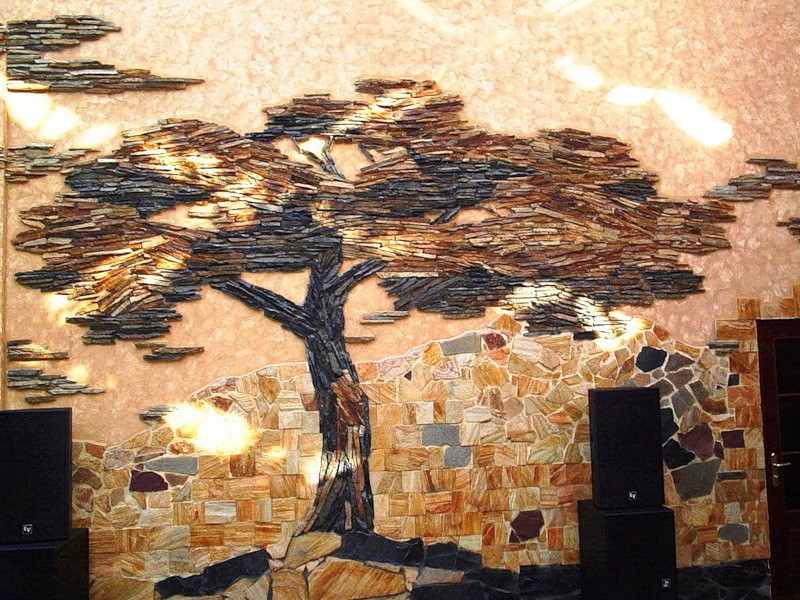
Since wall decoration with artificial stone has been quite popular lately, manufacturers of finishing materials are trying to diversify their range.
At the moment there are:
- Artificial brick-like stone for interior decoration,
- Under marble.
- Sandstone.
- Granite.
- Bassoon and so on.
All these types are not as bulky as natural agglomerates and not so heavy, and for their installation it will not be necessary to additionally strengthen the surface.
Advantages of decorative stone:
- Regardless of what material the decorative stone is made of, all its types are considered environmentally friendly.
- They are not able to absorb moisture and various pollution.
- Their surface is quite easy to clean.
Advice. Particular care must be taken with decorative gypsum stone, as it can easily be deformed under the influence of physical and mechanical forces.
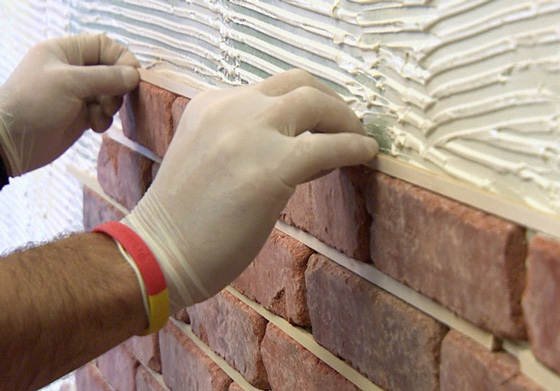
- Any decorative stone is easy to install and easy to use.
- Its cost is much lower than natural, which determines the demand for it.
- With its help, a unique design is created in the interior.
You can use decorative stone on:
- walls.
- Bar counters.
- Arches (see).
The photo shows examples of interior design using this finishing material.
Application of decorative stone:
- Installation of decorative stone is quite simple.
- It should be noted that it is carried out only on a flat surface.
- Previously, it needs to be done preparatory work for leveling, cleaning and processing.
Preparatory work for fixing artificial stone:
- Interior decoration with artificial stone begins with surface preparation. If the surface is flat, then leveling is not required. Cleaning work is in progress.
- If there are layers of plaster on the surface, then with a hammer it is necessary to remove those that have moved away from the surface. If the surface is without flaws, then it must be degreased using special tools.
Advice. Before installing the decorative stone, the surface must be primed to improve the bonding of the adhesive solution with the finishing materials and with the surface itself.
If the surface has sufficiently visible defects and irregularities, then with the help of drywall or plaster you can eliminate them.
The use of drywall
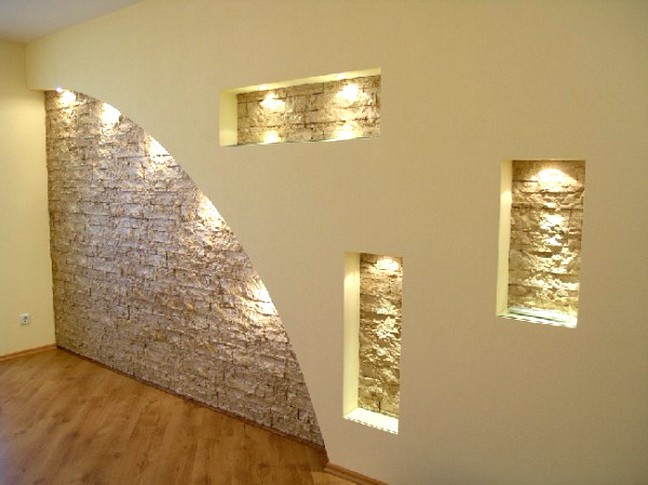
It is worth considering that such a finishing material is attached to the frame, then it is not recommended to use it in rather small rooms, since this hides space (the height of the frame depends on the irregularities on the surface).
The frame is mounted on the surface using:
- metal profiles.
- Self-tapping screws.
- dowels.
- Screwdriver.
Mounting:
- Drywall sheets of the desired size are attached to this frame using self-tapping screws and a screwdriver.
- All joints of the sheets are glued with construction tape, on which a layer of putty is applied. After that, all seams are processed with sandpaper.
- On the video you can see the process of installing drywall sheets on a profile frame.
- During the installation of drywall, insulation work can be carried out using foam or other solid mineral insulation.
Advice. For the installation of decorative stone, it is best to use moisture-resistant drywall.
The use of plaster
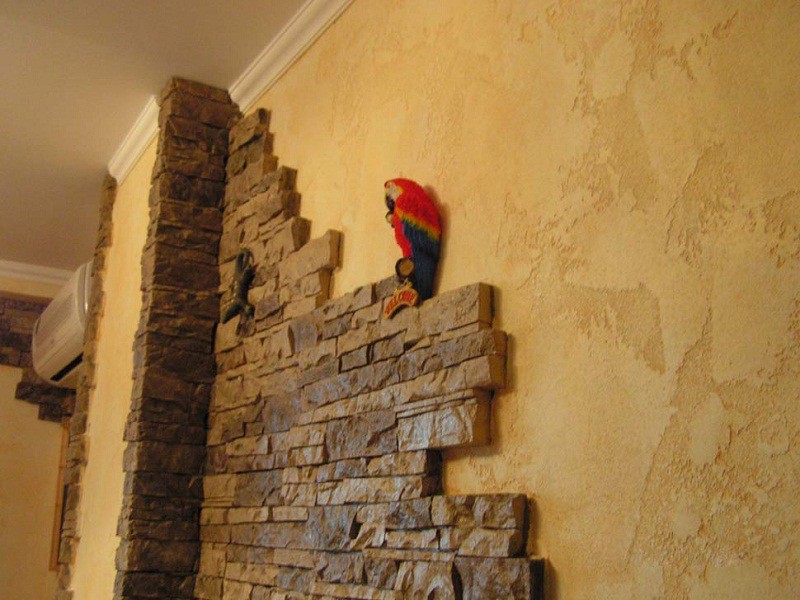
To level the surfaces, only the starting and finishing ones are used, which are sold in dry bulk form, and for the manufacture of the solution on their packaging there is an instruction according to which a certain amount of water must be added.
There are currently three types of this tool:
- Starting plaster.
- Finishing.
- Decorative.
To level the surface with plaster you will need:
- Container for mixing solution.
- Two spatulas.
- Level.
- Construction grid.
- Construction mixer.
So:
- You can knead the solution with your own hands, only it can take quite a lot of time.
- And with the use of a construction mixer, the whole process will take place much faster and the solution itself will turn out to be of better quality.
- The initial starting plaster is applied to the surface in several layers, then allowed to dry and sanded.
- Then they are already superimposed finishing plaster, which helps to hide the defects of the starting layer. It should also be processed with sandpaper.
Installation of decorative stone
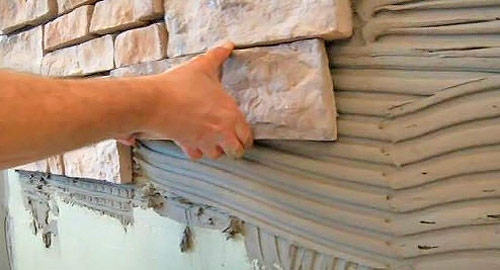
Using artificial facing stone for interior decoration is quite simple.
If the surface has already been prepared, then for the installation of this material you will need:
- Concrete or adhesive mortar.
- Level.
- spatula.
- Finishing material.
- Decorative putty (if necessary).
Advice. To increase the strength of the surface and ensure a high-quality finish, a construction mesh can be mounted on the surface.
Initially, a concrete solution is mixed, for which you will need:
- Water.
- Cement.
- Sand.
Mounting:
- You can immediately buy a ready-made adhesive solution, which is diluted with water to the required consistency (thick sour cream).
- The solution is initially applied to the surface of the wall and held without finishing material for several minutes. After that, a solution is applied to the inner surface of the decorative stone and the material itself is leaned against the wall and fixed on it.
- Each trim element must be level. But this is only if the artificial stone for wall decoration has rectilinear shapes.
- After the installation of the decorative stone is completed, the seams can be treated with a special putty.
Artificial stone finish is very practical and durable. But here it is necessary to pay special attention to the room in which it is used.
Decorative stone is not recommended for decoration kitchen aprons, since it will not work to clean fatty formations from its surface without the use of abrasive agents. It is better to use it on walls, arches.
He found wide application in outdoor finishing works. Facades with its decor look original and rich.

